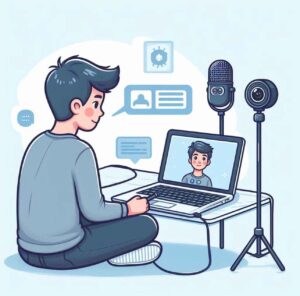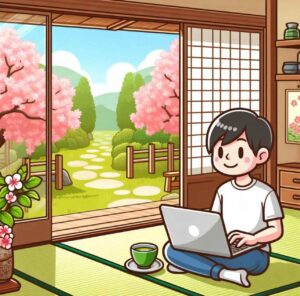Welcome Blessings!
(Tap 🔽 to see more topics!)


Video interviews aren’t just a trend anymore; they’re the new normal, and honestly, it’s like trying to have a serious conversation while your cat decides your keyboard is the perfect napping spot or your internet connection chooses that exact moment to mimic dial-up from the 90s. That’s the reality of modern job hunting. We have all seen the news: remote work isn’t just a fad; it’s a fundamental shift. Companies are finding fantastic talent globally, and candidates are discovering jobs that fit their lives, not just their location. It means fewer stuffy commutes and more opportunities but also facing a new world of digital introductions.
Sure, skipping the travel and saving time is a huge win. But let’s be honest: a video call differs from sitting across a desk from someone. Suddenly, your background, lighting, and even how your voice sounds through a microphone matters more than ever. You’re not just selling your skills but your ability to present yourself professionally in a digital space. Technical glitches, unexpected noises, and the sheer awkwardness of staring at your face on a screen can throw anyone off their game.
Luckily, mastering the art of the video interview isn’t rocket science. Today, you will learn the essential dos and don’ts, giving you tips from an HR perspective to shine online and land that dream job, even if your cat is determined to be the show’s star!
That moment, your computer decides to freeze right when you need it the most. So, a little prep goes a long way when it comes to a video interview. Think of it like a dress rehearsal for your digital debut.

Have you ever heard the phrase ‘first impressions matter’? Well, that starts before you even say a word in the digital age. Your username and email address are often the first things a potential employer sees. They’re like your digital handshake.
Using an unprofessional username or email can instantly give the wrong impression. It might make you look immature, careless, or even unprofessional. You don’t want to start your job search with a strike against you!
1. Usernames– Choose something straightforward when setting up your video call accounts (Zoom, Skype, Google Meet, etc.).
2. Email Addresses– Your email is your digital calling card.
Why does this matter?
Bonus Tip: Your profile picture is part of this, too. Choose a photo that’s:
It’s all about putting your best foot forward, even before the interview starts. It’s a small detail, but it can make a big difference!
Video interviews are here to stay; honestly, they’ve flipped the script on how we land jobs. You can interview from your own space without travel headaches, and companies can meet awesome people they might have missed otherwise. But there’s a catch- your living room suddenly becomes your stage, and you’ve got to make it work.
One of the biggest things is picking the perfect spot. It’s not just about looking good; it’s about setting yourself up for success.

Look, it’s all about creating an environment where you can shine. You want the interviewer to focus on you, not the pile of laundry in the background. A little prep goes a long way, showing you’re serious about the opportunity.
It’s easy to think, “It’s just a screen; nobody will notice,” but trust me, they do. Dress like you’re going to the office. Even if you’re interviewing from your kitchen table, wear something to an actual, in-person interview. Think business casual or whatever the company culture suggests.
Why does it matter?
What to avoid?
Comfort is key. You’ll sit for a while, so make sure your clothes fit well and aren’t itchy or uncomfortable. Also, grooming matters. Make sure your hair is neat. A clean face and brushed teeth go a long way.
You want to look like you made an effort. It’s not about being a fashion model but showing that you take this seriously. Think of it as showing up prepared like you would for an in-person meeting.
You wouldn’t attend a first date without knowing anything about the person, would you? The same goes for a job interview, primarily online. You’re walking into a digital room and want to show them you’re not just some random face on a screen. You’ve got to do a little digging. It’s not about memorizing their history but showing you’ve put in the effort.

1. What’s their deal?
2. Who are they talking to?
3. Does this job fit you?
4. Ask questions!
Why bother? Because it shows you’re interested, not just spamming your resume everywhere. Plus, it helps you determine if you want to work there. You’re interviewing them as much as they’re interviewing you. You want to make sure it’s a good fit both ways.
Being late is a major red flag. You wouldn’t stroll into a doctor’s appointment 20 minutes late, would you? It’s about respecting everyone’s time. Does it matter? Yes! It shows you’re reliable. Also, it tells the interviewer you’re genuinely interested. And it avoids starting the interview flustered and stressed. Below is a simple plan to nail the timing:
Having everything organized means you’re not scrambling at the last minute and can focus on making a great impression. It’s really about showing you’re prepared and taking the interview seriously.
It’s not just about your resume anymore; it’s about how you come across on that little screen. And honestly, staring at a camera is weird at first. But remember:

It’s about making that connection, even through a screen. You want to come across as someone who’s not only capable but also someone easy to get along with. And those little things make a huge difference: the smile and eye contact!
Have you had those awkward video interview moments where you accidentally talk over someone because of a tiny internet delay? It’s like speaking through a walkie-talkie with a bit of static. It’s super easy to step on each other’s words accidentally. But those little delays are just part of the video call experience. So, how do we handle them without sounding rude?
It boils down to being mindful and understanding that technology isn’t always perfect. We’re all human; a little grace goes a long way in a video interview.
Behavioral or situational questions are among the most common questions in an interview. An example is when the interviewer asks you to describe a specific situation from your experience that demonstrates your skills or abilities for the job. They might ask you to tell them when you solved a problem, handled a conflict, led a team, or achieved a goal. To answer these questions effectively, use the STAR method, which stands for Situation, Task, Action, and Result.
Using the STAR method will help you provide specific and relevant examples that showcase your strengths and potential for the job.
It’s tempting to puff up your resume a little or stretch the truth about a skill here and there. But trust me, it’s a recipe for disaster.
The bottom line is to be honest and realistic about what you bring to the table. It’s about finding the right job for you, not just any job. And that starts with being authentic.
Okay, you’ve just finished the interview; great job! But don’t just sit back and wait. A quick follow-up is like putting a cherry on top of a successful interview. It shows you’re genuinely interested in the job and helps keep you fresh in the interviewer’s mind. Plus, it’s just plain professional.
Aim to send a thank-you email or message within 24 hours. In it, thank them for their time, clearly state your continued interest in the position, and briefly remind them of a key skill or experience that makes you a good fit. If you need to clarify anything from the interview, now’s the time. Finally, say you look forward to hearing about the next steps. A thoughtful follow-up can make a real difference.

You send out applications, ace an interview, and then… silence. It’s easy to feel discouraged, wondering if you said the wrong thing or if your resume got lost in the digital void. However, hiring decisions are complex. Budgets shift, timelines change, and finding the perfect fit sometimes takes time. It’s not always about you. So, focus on what you can control instead of letting doubt creep in.
Patience and persistence are your best allies. Keep those applications going, and don’t put all your eggs in one basket. Explore different roles and companies; you might discover opportunities you never considered. While you’re waiting, use this time to level up. Update your resume, practice your interview skills, and build your network. Reach out to people in your field, attend virtual events, and make meaningful connections.
Most importantly, keep learning. Take online courses, read industry blogs, and stay curious. Every step you take is an investment in your future. Remember, every “no” gets you closer to a “yes.” Keep your chin up, keep growing, and keep pushing forward. Your next opportunity is out there!
Look, video interviews might seem weird at first. Staring at a screen instead of someone’s eyes can feel like talking to a wall. Remember that they’re a part of how we find jobs now; honestly, they open many doors. Imagine you can connect with companies worldwide from your living room. And that’s pretty cool!
So, don’t let the tech freak you out. Remember those tips we talked about? They’re not just rules; they’re your tools. Use them to show off your fabulous self. Be genuine, let your personality shine, and don’t be afraid to be a little creative. You’re not just a face on a screen; you’re a person with skills and dreams, and that’s what matters.
We hope this guide helped you feel more confident about your following video interview. If you’ve got any questions or a funny video interview story of your own, drop them in the comments below! We’d love to hear from you. And if you want even more interview tips and tricks, check out our budding YouTube channel to help you land that dream job. Now go out there and rock that interview! Voila! Until next time!